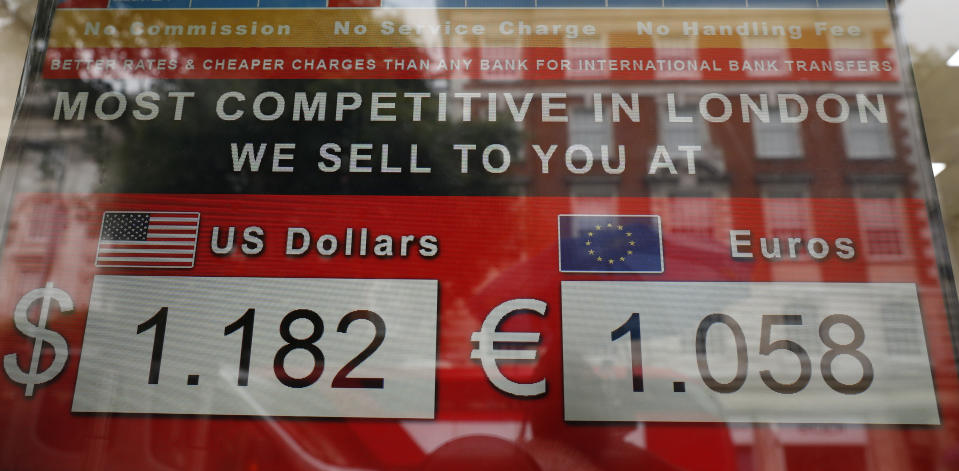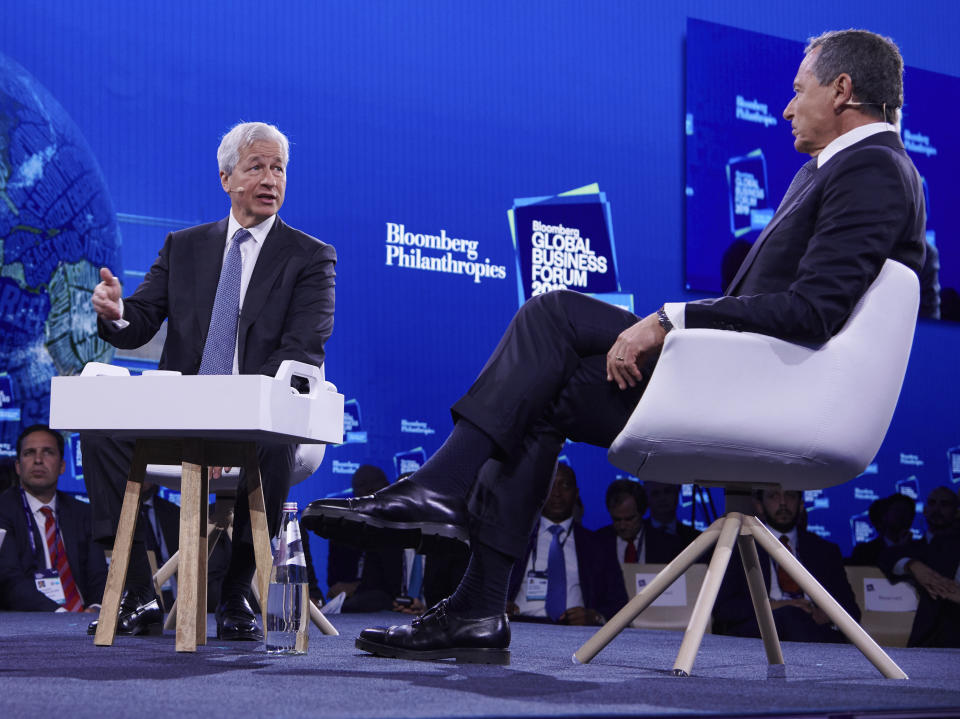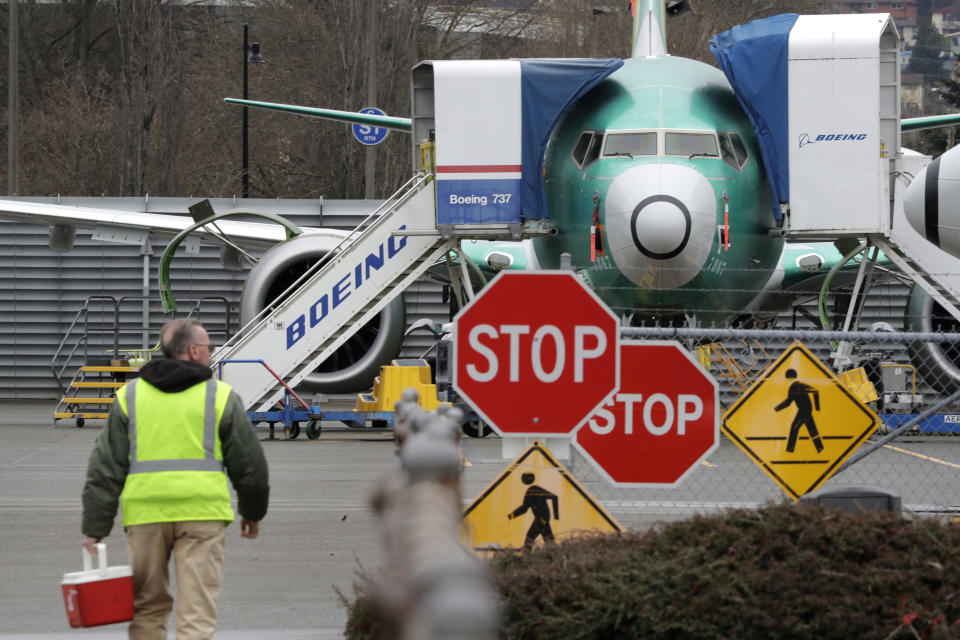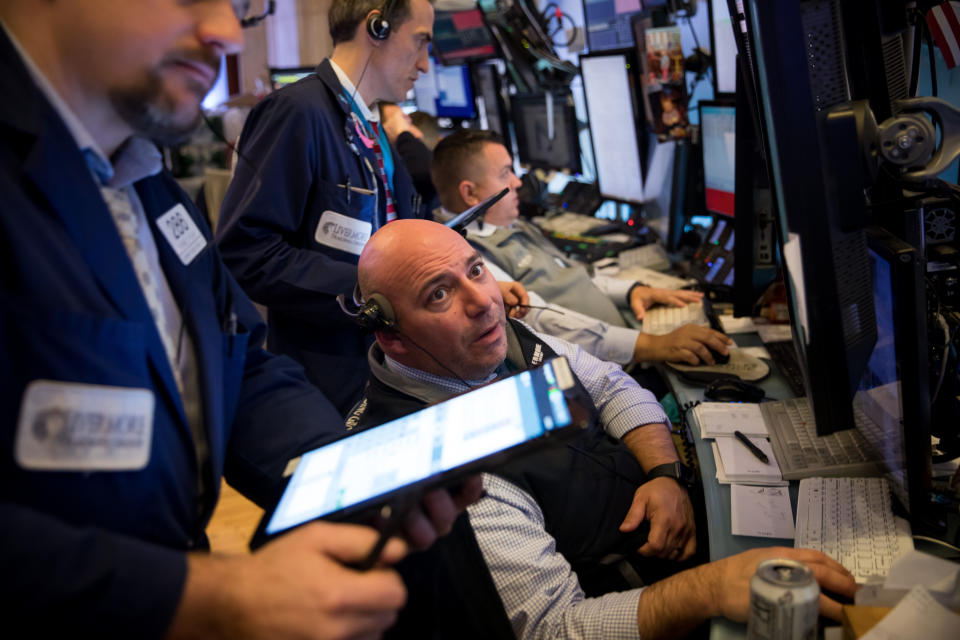Stock market news live: Wall Street tumbles as coronavirus panic trumps blockbuster jobs data
Wall Street clawed off the session’s deep troughs on Friday, but still ended the day in the red. Markets have endured over 2 weeks of near-continuous selling on the coronavirus outbreak that’s rattling investors and paralyzing the global economy.
In China, the epicenter of the viral outbreak that’s now overshadowed the growth outlook, new infections are on the decline. Yet in places like South Korea, Iran, Italy, and the United States, the crisis has barely just begun: Over 100,000 people have been infected and more than 3,400 are dead — the majority in China, but new infections and deaths outside the Middle Kingdom are soaring. States like California, Washington and New York have emerged as the first wave in an American outbreak that’s all but guaranteed to get worse.
A monster February jobs report, in which the economy created 273,000 positions during the month, failed to quell the market’s panic over the COVID-19 epidemic. Amidst the selling, the market’s volatility gauge (VIX) hit its highest levels since January 2009.
“There is no use in spending much time paying attention to the economic data we see this week – it’s useless,” said Hank Smith, Co-CIO of Haverford Trust, which has around $9.5 billion in assets under management.
Among analysts, the deep sell-off has raised expectations of the Federal Reserve cutting interest rates sooner rather than later — something the central bank was forced to do in an emergency session earlier this week.
Meanwhile, fears are growing that the global economy may be tipped into a recession as each affected country tries to contain the outbreak, and the spillover on business activity.
“The market is obviously quickly pricing in a negative impact to GDP and a negative impact to earnings growth,” Smith added. “We just don’t know to what extent that negative impact is, but it’s most likely a two-quarter event.”
Take our quick poll: Do you think the stock market has bottomed?
—
4 p.m. ET: Stocks end lower as virus fears intensify
Panic selling drove Wall Street to yet another consecutive losing week as the global coronavirus count tops 100,000, with no end in sight. Bonds are yielding their lowest-ever rates as panic-stricken investors look for shelter in Treasuries, gold and the Japanese yen. Oil was the day’s biggest loss leader by far, hammered by OPEC’s inability to strike a deal on a production cut.
Here’s where the major benchmarks closed:
S&P 500 (^GSPC): 2,972.46, down -51.48 or -1.70%
Dow (^DJI): 25,867.76, off -253.52 or -0.97%
Nasdaq (^IXIC): 8,575.62, off -162.98 or -1.87%
Crude oil (CL=F): $41.31, down -$4.59 or -10.00%
Gold (GC=F): $1,671.10, up $3.10 or +0.19%
10-year Treasury (^TNX): yielding 0.706%, down 22 basis points
—
3:15 p.m. ET: Is the dollar still a safe-haven?

Yes...and no. In the current sell-off, logic would suggest the dollar should be strengthening, but it’s not: The buck is broadly weaker, especially against the yen (JPY) and euro (EUR).
Yet as Bank of America points out, it’s really an unwinding of risk-sensitive “carry trades” (borrowing in a low-yielding currency to fund purchases of higher-yielding risk assets) that’s dragging down the greenback:
As the impact of [coronavirus] on the global economy continues worsening, the unwinding of carry trades benefits JPY and EUR against USD and EM. Depreciation and inverted vol curves highlight stress in commodity EM FX.
We assess the FX market impact of [coronavirus] so far and discuss implications ahead. As the correlation of DXY with market distress has turned negative, we expect more USD downside vs. JPY and EUR.
—
3 p.m. ET: Crude suffers worst daily loss since December 2008
Oil (CL=F) markets took it on the chin after OPEC+ members failed to strike a deal to cut production to prop up sagging prices. As a result, crude plunged a stunning 10% on the day, closing at its lowest levels since the financial crisis. The rest of the market isn’t doing much better, as coronavirus fears trigger more panic selling.
—
2 p.m. ET: Stocks hold lows as virus-hit markets keep falling
Stocks pull off their weakest levels of the day, but are firmly in the negative column as the global coronavirus count tops 100,000 with no end in sight. Bonds are yielding their lowest-ever rates as panic-stricken investors look for shelter in Treasuries, gold and the Japanese yen.
Here were the main moves in markets as of 2 p.m. ET:
S&P 500 (^GSPC): 2,936.43, off -87.51 or -2.89%
Dow (^DJI): 25,569.81, off -551.47 or -2.11%
Nasdaq (^IXIC): 8,461.05, off -277.54 or -3.18%
Crude oil (CL=F): $42.13, off -$3.77 or -8.21%
Gold (GC=F): $1,672.80, up +4.80 or +0.29%
10-year Treasury (^TNX): yielding 0.704%, down 22.1 basis points
Deutsche Bank’s Torsten Slok believes that “markets are pricing in a global recession. The question at this point for rates is whether the likely rebound in the Chinese PMI in March will be offset by a significant decline in ISM in the US and PMI in Europe.”
—
1:15 p.m. ET: JPMorgan holds lows, report says Dimon will make full recovery

The banking world was shaken late Thursday by news that JPMorgan Chase CEO Jamie Dimon — the Street’s longest-serving CEO and its most prominent voice — had an emergency heart procedure. CNBC reported on Friday that Dimon is expected to “fully recover” from the incident. The stock (JPM) fell more than 5% in Friday’s trading, with the entire market pinned in the red.
Nevertheless, it raises questions about JPMorgan’s succession plans, a topic that’s surfaced before but one Dimon has been reluctant to broach. That said, last year’s executive role changes for its two top women at the firm resulted in speculation that the largest U.S. bank might be the first to see a female CEO at the helm.
__
12:25 p.m. ET: FAA faulted for Boeing 737 MAX woes

The embattled aerospace giant was responsible for “design failures” behind two 737 MAX crashes that killed 346 people, according to a Congressional investigative report obtained by Reuters — but regulators were also to blame. The preliminary document found the Federal Aviation Administration’s "certification review of Boeing’s 737 MAX was grossly insufficient and that the FAA failed in its duty to identify key safety problems."
Boeing’s (BA) stock, one of 30 stocks in the Dow (^DJI), was down over 1% in midday trading in a coronavirus-weakened market.
—
11:30 a.m. ET: This sell-off ‘has further to go’
There’s no rest for weary investors, according to Deutsche Bank, which on Friday released a grim analysis of the current rout — and came to the conclusion that it’s not over.
Against a backdrop of significant initial overvaluation, all four historical playbooks suggest the magnitude of the selloff in the S&P 500 (^GSPC) so far (-13% to last Friday’s closing low) has further to go; and in terms of duration, just 2 weeks in, it is much too early to declare this episode as being done.
Our baseline view is for a total sell off from the last peak of 15-20%, with a bottom some time in Q2. We do view the impacts on macro and earnings growth as being relatively short-lived and the market eventually looking through them and maintain our year-end target of 3250 for the S&P 500.
Like most of Wall Street economists, the firm thinks the economic impact will be substantial — but relatively brief:
While it is clear that the fundamentals in terms of macro and earnings growth will slow, there is a wide range around how much and for how long. Our house view, while noting that uncertainty is unusually high, lays out a central scenario that sees a sharply negative impact on activity in Q2; but relatively brief in duration, with a recovery beginning in Q3.
__
10:50 a.m. ET: The coming lobster bear market

Amid the coronavirus outbreak, there are at least two items consumers can count on getting for cheap: Gas (linked to oil prices, which are plunging — and something economists say acts like a tax cut for consumers ), and...lobsters.
Yes, you heard that correctly. Via Bloomberg:
U.S. lobster prices have plummeted to the lowest in at least four years after the spread of the virus halted charter flights to Asia at a time when sales usually boom for Chinese New Year celebrations.
The fallout has left thousands of pounds of unsold lobster flooding North American markets and squeezing U.S. businesses that were already hurting from lost sales due to China’s tariffs from its trade war with Washington.
—
10:20 a.m. ET: Crude sinks to near 3-year lows after OPEC deal fails
The meeting of oil-producing countries ended without a deal, which has sent crude (CL=F) reeling to under $44, its lowest since June 2017.
Oil has been under intense downward pressure from expectations that the coronavirus epidemic would hammer global demand (especially with airlines canceling or curtailing flights). But OPEC+’s desire to backstop prices with a production cut was hampered by resistance from Russia and Saudi Arabia — the two largest and most powerful members.
__
10:10 a.m. ET: ‘For what it's worth the February job market was booming’
Rarely, if ever, has one of the market’s most closely-watched data series been rendered so irrelevant by events.
In a different time the jobs data would have sparked a massive rally: Instead, the coronavirus crisis has completely overtaken market psychology — something JPMorgan’s Michael Feroli expects may compel the Fed to push rates “all the way to zero.”
Among the report’s good news:
... there was a large gain in government jobs again last month, up 45,000, mostly at the state and local level. In the private sector goods-producing jobs were up 61,000 last month—the most in just over a year—led by a 42,000 increase in construction employment. Service sector job growth was paced by a 51,000 increase in leisure and hospitality employment; presumably this industry will get decimated in March. The increase in the all-worker workweek was matched in the production and non-supervisory worker series, which ticked up to 33.7 hours. Likewise, average hourly earnings for this better-measured subset of overall employment increased 0.3% last month, leaving the year-ago reading unchanged at 3.3%.
Capital Economics also sums it up nicely:
All of this data precede the coronavirus impact, however, so the markets will largely ignore it. With the 10-year Treasury yield slumping to a new record low and stock markets under pressure again today, it is questionable whether the Fed can wait until its scheduled meeting mid-month to deliver the next rate cut.
—
9:32 a.m. ET: Stocks open lower even after blowout jobs report
Overnight losses carried into regular trading, with each of the S&P 500, Dow and Nasdaq opening sharply lower Friday morning.
Here were the main moves in markets as of 9:32 a.m. ET:
S&P 500 (^GSPC): 3,908.00, down -107.5 points or -3.56%
Dow (^DJI): 25,217.00, down -843.00 or -3.23%
Nasdaq (^IXIC): 8,325.00, down -323.75 or -3.74%
Crude oil (CL=F): $44.21, down 1.69 or -3.68%
Gold (GC=F): $1,685.20, up $17.20 or +1.03%
10-year Treasury (^TNX): yielding 0.704%, down 22.1 basis points
—
9:11 a.m. ET: ‘This could be the last perfect employment report the market gets for some time,’ economist says
As many economists have been quick to point out, the February jobs report was obsolete since even before its release, as it captured the period before the coronavirus outbreak escalated and became a meaningful threat to economic activity.
“This could be the last perfect employment report the market gets for some time,” Chris Rupkey, chief financial economist for MUFG Union Bank, wrote in a note Friday. “Net, net, the employment report was nearly perfect in February before the growing economic storm posed by the spreading coronavirus around the country that threatens many industries where the public gathers from movies, to travel, to the airline industry, even shops and malls.”
“The Federal Reserve cut rates this week because of a material change in the outlook as posed by the spread of the virus,” Rupkey added. “Although there is nothing in the February employment report to suggest a slowdown in the economy, the market continues to bet big on another interest rate cut from Fed officials later this month.”
At the same time, the strong employment report means the U.S. economy was in a better position to handle the coronavirus outbreak than it would have been in absence of such momentum at the start of the year, other pundits pointed out.
“It is a good thing, not a bad thing that the US economy ran into the coronavirus on a strong footing,” Neil Dutta, head of economics at Renaissance Macro Research, said in an email Friday. “Yes, this was stale. But the economy is dealing with this from a position of strength.”
—
8:49 a.m. ET: Markets continue to trade lower, yields tumble
The better-than-expected U.S. jobs reported didn’t really move the needle on markets.
S&P 500 futures (ES=F): 2,934.25, down 81.25 points or -2.69%
Dow futures (YM=F): 25,412.00, down 648 points or -2.49%
Nasdaq futures (NQ=F): 8,389.25, down 259.50 points or -3.00%
Crude oil (CL=F): $44.03 per barrel, down $1.87 or 4.07%
Gold (GC=F): $1,674.80 per ounce, up $6.80 or 0.41%
10-year Treasury (^TNX): yielding 0.751%, down 18.9 bps
—
8:30 a.m. ET: U.S. jobs report smashes expectations.
U.S. employers added 273,000 payrolls in February, beating economists’ expectations for 175,000. The unemployment rate fell to 3.5% from 3.6% the month prior.
Average hourly earnings climbed by 0.3% month-over-month, or 3.0% year-over-year, which was in line with expectations.
Note: the measurement period for this report predates the period during which coronavirus fears spiked globally.
Read more about the jobs report here.
—
7:49 a.m. ET: Stock futures sink, following global equities lower
U.S. stocks were on track for another down day, with futures for each of the S&P 500, Dow and Nasdaq off more than 2% in early trading.
In the U.S., the number of confirmed cases of COVID-19 broke above 200, with the White House acknowledging Thursday that the nation lacks an adequate amount of coronavirus test kits to meet demand. Globally, the number of cases of the coronavirus is nearing 100,000, with more than 3,200 deaths reported.
The escalating outbreak has dented stocks and sent Treasury yields spiraling lower. The yield on the benchmark 10-year note broke below 0.75% Friday morning as traders piled into safe haven assets like government bonds.
The impending release of Department of Labor’s February jobs report has done little to prop up equities, even as consensus economists expect another strong print on payroll gains and an unemployment rate near a 50-year low. The release, however, will capture the state of the labor market before the escalation of the coronavirus outbreak in the U.S., rendering the report already stale.
Here were the main moves during the pre-market session, as of 7:49 a.m. ET:
S&P 500 futures (ES=F): 2,939.25, down 76.75 points or -2.53%
Dow futures (YM=F): 26,449.00, down 611 points or -2.34%
Nasdaq futures (NQ=F): 8,407.50, down 241.25 points or -2.79%
Crude oil (CL=F): $43.95 per barrel, down $1.95 or 4.25%
Gold (GC=F): $1,686.00 per ounce, up $18.00 or 1.08%
10-year Treasury (^TNX): yielding 0.739%, down 18.6 bps

—
Follow Yahoo Finance on Twitter, Facebook, Instagram, Flipboard, LinkedIn, and reddit.
Find live stock market quotes and the latest business and finance news
For tutorials and information on investing and trading stocks, check out Cashay